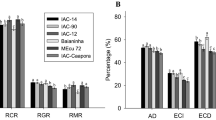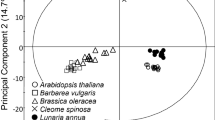Abstract
Determination of the feeding history of polyphagous insect pests, such as noctuid moths (Lepidoptera: Noctuidae), is a critical element in developing population and resistance management strategies for such pests. To identify reliable markers for larval host plant determination and to develop simple extraction and detection methods, a metabolomics approach was implemented after acid hydrolysis of adult moth samples. We identified a derivative from cotton metabolites as a marker in adult moths that were fed cotton tissues as a larval diet, and we propose that the marker is tricycloheliocide H4 based on NMR and mass fragmentation analysis. Using this derivative from cotton metabolites as a marker, a targeted LC-MS/MS method reliably identified cotton as a larval diet in extracts of three noctuid moth species: Helicoverpa zea (cotton bollworm), Chloridea (Heliothis) virescens (tobacco budworm) and Chrysodeixis includens (soybean looper). We are using similar approaches to identify markers for other host plants including soybean.





Similar content being viewed by others
Data Availability
All data were captured within the manuscript with supplementary materials.
References
Benedict C, Martin G, Liu J, Puckhaber L, Magill C (2004) Terpenoid aldehyde formation and lysigenous gland storage sites in cotton: variant with mature glands but suppressed levels of terpenoid aldehydes. Phytochemistry 65:1351–1359
Bell A, Stipanovic R, O’Brien D, Fryxell P (1978) Sesquiterpenoid aldehyde quinines and derivatives in pigment glands of Gossypium. Phytochemistry 17:1297–1305
Bezemer T, Wagenaar R, Van Dam N, Van Der Putten W, Wackers F (2004) Above- and below-ground terpenoid aldehyde induction in cotton, Gossypium herbaceum, following root and leaf injury. J Chem Ecol 30:53–67
Celorio-Mancera M, Aha S, Vogel H, Heckel D (2011) Transcriptional responses underlying the hormetic and detrimental effects of the plant secondary metabolite gossypol on the generalist herbivore Helicoverpa armigera. BMC Genomics 12:575
Chiang W-D, Shih C-J, Chu Y-H (2001) Optimization of acid hydrolysis conditions for total isoflavones analysis in soybean hypocotyls by using RSM. Food Chem 72:499–503
Dong H-L, Zhang S-X, Tao H, Chen Z-H, Li X, Qiu J-F, Cui W-Z, Sima Y-H, Cui W-Z, Xu S-Q (2017) Metabolomics differences between silkworms (Bombyx mori) reared on fresh mulberry (Morus) leaves or artificial diets. Sci Rep 7:10972
Duffey S (1980) Sequestration of plant natural products by insects. Annu Rev Entomol 25:447–477
Elliger C, Chan B, Waiss A (1978) Relative toxicity of minor cotton terpenoids compared to gossypol. J Econ Entomol 71:161–164
Gould F, Blair N, Reid M, Rennie T, Lopez J, Micinski S (2002) Bacillus thuringiensis-toxin resistance management: stable isotope assessment of alternate host use by Helicoverpa zea. Proc Natl Acad Sci U S A 99:16581–16586
Hansen PE, Spanget-Larsen J (2017) NMR and IR investigations of strong intramolecular hydrogen bonds. Molecules 22:552
Head G, Jackson RE, Adamczyk J, Bradley JR, Van Duyn J, Gore J, Hardee DD, Leonard BR, Luttrell R, Ruberson J, Mullins JW, Orth RG, Sivasupramaniam S, Voth R (2010) Spatial and temporal variability in host use by Helicoverpa zea as measured by analyses of stable carbon isotope ratios and gossypol residues. J Appl Ecol 47:583–592
Jones P, Petschenka G, Flacht L, Agrawal AA (2019) Cardenolide intake, sequestration, and excretion by the monarch butterfly along gradients of plant toxicity and larval ontogeny. J Chem Ecol 45:264–277
Kleinpeter E, Lämmermann A, Kühn H (2011) The anisotropic effect of functional groups in 1H NMR spectra is the molecular response property of spatial nucleus independent chemical shifts (NICS)—conformational equilibria of exo/endotetrahydrodicyclopentadiene derivatives. Org Biomol Chem 9:1098–1111
Liu J, Benedict CR, Stipanovic RD, Bell AA (1999) Purification and characterization of S-adenosyl-L-methionine: Desoxyhemigossypol-6-O-methyltransferase from cotton plants. An enzyme capable of methylating the defense terpenoids of cotton. Plant Physiol 121:1017–1024
McCormick JP (1982) Secondary metabolites of Gossypium: a biogenetic analysis. In: Montalvo J (ed) Cotton dust. ACS symposium series, Vol. 189. American Chemical Society, Washington, DC, pp. 275–300
Opitz S, Kunert G, Gershenzon J (2008) Increased terpenoid accumulation in cotton (Gossypium hirsutum) foliage is a general wound response. J Chem Ecol 34:508–522
Orth R, Head G, Mierkowski M (2007) Determining larval host plant use by a polyphagous lepidopteran through analysis of adult moths for plant secondary metabolites. J Chem Ecol 33:1131–1148
Park S-H, Scheffler J, Scheffler B, Cantrell C, Pauli CS (2019) Chemical defense responses of upland cotton, Gossypium hirsutum L. to physical wounding. Plant direct 3:e00141
Prashad M, Seth M, Bhaduri AP, Banerji A (1980) 13C NMR studies: effect of steric compression on chemical shifts of carbons in diastereoisomers. Org Magn Reson 14:74–75
Riach AC, Perera MVL, Florance HV, Robinson LA, Penfield SD, Hill JK (2019) Metabolic fingerprints reveal how an insect metabolome is affected by different larval host plant species. Arthropod Plant Interact 13:571–579
Stipanovic R, Bell A, O’Brian D, Lukefahr M (1977a) Heliocide H2: an insecticidal sesterterpenoid from cotton (Gossypium). Tetrahedron Letter 6:567–570
Stipanovic RD, Bell AA, Lukefahr MJ (1977b) Natural insecticides from cotton (Gossypium). In: Hedin PA (ed) Host plant resistance to pests. ACS symposium series, Vol. 62. American Chemical Society, Washington, DC, pp. 197–214
Acknowledgments
We appreciate an early effort on structure elucidation by Lloyd Sumner (University of Missouri), Martin Ruebelt and Bosong Xiang (Bayer US Crop Science), and insect rearing by the Plant Biotech Entomology group (Bayer US Crop Science). We also are grateful to Paula Price and Ben Yorke for reviewing the manuscript.
Funding
All authors were employees of Bayer Crop Science, and the work was funded by Bayer Crop Science.
Author information
Authors and Affiliations
Contributions
Jae Hak Kim and Graham Head designed and coordinated the project. Jae Hak Kim, Andreas Lagojda, Dieudonné Tshitenge Tshitenge, Daniel P. Walker, Graham Head wrote the manuscript. Jae Hak Kim performed metabolomics and LC-MS work while Andreas Lagojda, Dirk Kuehne and Dieudonné Tshitenge Tshitenge generated and interpreted NMR data and structure elucidation. Swapan Chaudhuri and Daniel P. Walker contributed to the interpretation of NMR data and a mechanism of the marker production.
Corresponding author
Ethics declarations
Conflicts of Interest
The authors declare that they have no conflict of interest.
Ethics Approval
Not applicable.
Consent to Participate
All authors consented to a participation in this project.
Consent for Publication
All authors reviewed and approved the final version of the manuscript.
Code Availability
Not applicable.
Electronic supplementary material
ESM 1
(DOCX 7790 kb)
Rights and permissions
About this article
Cite this article
Kim, J.H., Lagojda, A., Kuehne, D. et al. Determination of Cotton as a Larval Feeding Source for Lepidopteran Moths Using a Derivative from Cotton Metabolites as a Marker by LC-MS/MS Method. J Chem Ecol 46, 956–966 (2020). https://doi.org/10.1007/s10886-020-01219-w
Received:
Revised:
Accepted:
Published:
Issue Date:
DOI: https://doi.org/10.1007/s10886-020-01219-w




